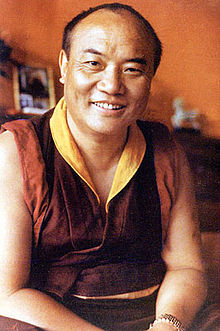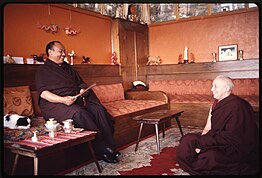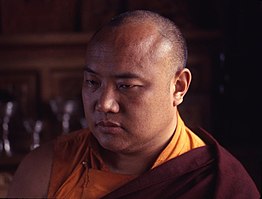
The Karmapa Tulku lineage of the Gyalwa Karmapa is the oldest among the major incarnating lineages of Tibetan Buddhism, established in 1110 CE by the 1st Karmapa, Düsum Khyenpa. Karmapa means “the one who carries out buddha-activity”, or “the embodiment of all the activities of the buddhas.” A total of 17 Karmapa manifestations have incarnated after their predecessors predict their own rebirths in detailed letters.
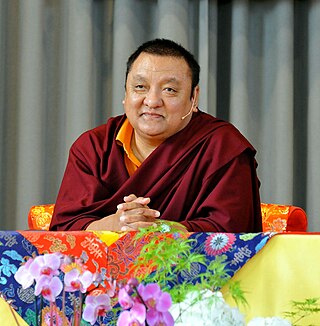
The Shamarpa, also known as Shamar Rinpoche, or more formally Künzig Shamar Rinpoche, is the second oldest lineage of tulkus. He is one of the highest lineage holders of the Karma Kagyu school of Tibetan Buddhism and is regarded as the mind manifestation of Amitābha. He is traditionally associated with Yangpachen Monastery near Lhasa.

Ole Nydahl, also known as Lama Ole, is a lama providing Mahamudra teachings in the Karma Kagyu school of Tibetan Buddhism. Since the early 1970s, Nydahl has toured the world giving lectures and meditation courses. With his wife, Hannah Nydahl (1946-2007), he founded Diamond Way Buddhism, a worldwide Karma Kagyu Buddhist organization with over 600 centers for lay practitioners.

Hannah Nydahl (1946–2007), wife of Lama Ole Nydahl, was a Danish teacher and translator in the Karma Kagyu lineage of Tibetan Buddhism.

Rumtek Monastery, also called the Dharma Chakra Centre, is a gompa located in the Indian state of Sikkim near the capital Gangtok. It is the seat in exile of the Gyalwang Karmapa, inaugurated in 1966 by the 16th Karmapa. It is also a focal point for the sectarian tensions within the Karma Kagyu school of Tibetan Buddhism that characterize the 17th Karmapa controversy.
There are currently two, separately enthroned 17th Gyalwang Karmapas: Ogyen Trinley Dorje and Trinley Thaye Dorje. The Karmapa is the spiritual leader of the nine-hundred-year-old Karma Kagyu lineage of the Kagyu school of Tibetan Buddhism.

Trinley Thaye Dorje is a claimant to the title of 17th Karmapa.

Kalu Rinpoche was a Tibetan Buddhist lama, meditation master, scholar and teacher. He was one of the first Tibetan masters to teach in the West.
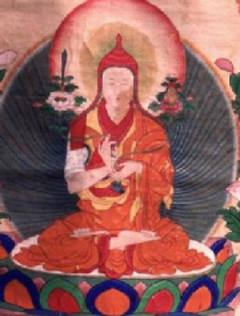
Jamgön Kongtrül Lodrö Thayé, also known as Jamgön Kongtrül the Great, was a Tibetan Buddhist scholar, poet, artist, physician, tertön and polymath. He is credited as one of the founders of the Rimé movement (non-sectarian), compiling what is known as the "Five Great Treasuries". He achieved great renown as a scholar and writer, especially among the Nyingma and Kagyu lineages and composed over 90 volumes of Buddhist writing, including his magnum opus, The Treasury of Knowledge.
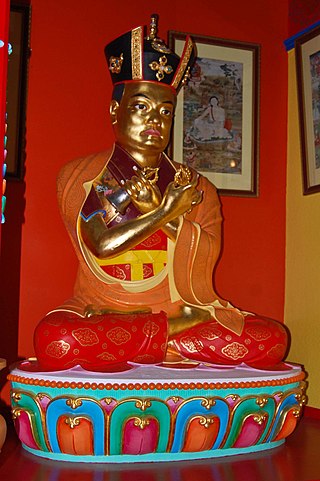
Karma Kagyu, or Kamtsang Kagyu, is a widely practiced and probably the second-largest lineage within the Kagyu school, one of the four major schools of Tibetan Buddhism. The lineage has long-standing monasteries in Tibet, China, Russia, Mongolia, India, Nepal and Bhutan, with current centres in over 60 countries. The spiritual head of the Karma Kagyu is the Gyalwa Karmapa; the 2nd among the 10 Karmapas had been the principal spiritual advisors to successive emperors of China. The Karma Kagyu are sometimes called the "Black Hat" lamas, in reference to the Black Crown worn by the Karmapa.
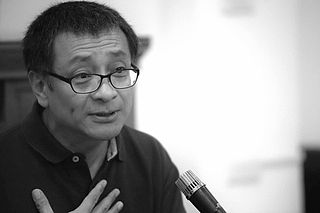
The 7th Dzogchen Ponlop is an abbot of Dzogchen Monastery, founder and spiritual director of Nalandabodhi, founder of Nītārtha Institute for Higher Buddhist Studies, a leading Tibetan Buddhist scholar, and a meditation master. He is one of the highest tülkus in the Nyingma lineage and an accomplished Karma Kagyu lineage holder.

Diamond Way Buddhism is a lay organization within the Karma Kagyu school of Tibetan Buddhism. The first Diamond Way Buddhist center was founded in 1972 by Hannah Nydahl and Ole Nydahl in Copenhagen under the guidance of Rangjung Rigpe Dorje, 16th Karmapa. Today there are approximately 650 centers worldwide, directed by Ole Nydahl under the guidance of Trinley Thaye Dorje, one of two claimants to the title of the 17th Karmapa. Buddhist teachers such as Sherab Gyaltsen Rinpoche, Lama Jigme Rinpoche and Nedo Kuchung Rinpoche visit Diamond Way Buddhism centers and large meditation courses.

Mipham Chokyi Lodro, also known as Kunzig Shamar Rinpoche, was the fourteenth Shamarpa of the Karma Kagyu school of Tibetan Buddhism. The Shamarpa is the second-most important teacher of the Karma Kagyu school, after the Karmapa.
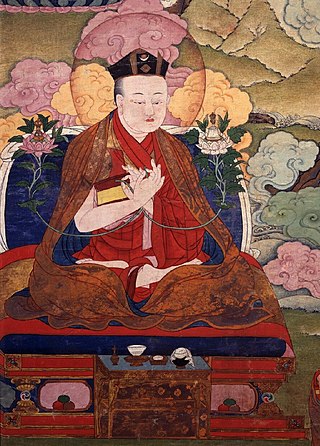
The 3rd Karmapa, Rangjung Dorje (1284–1339) was the 3rd Gyalwa Karmapa and head of the Karma Kagyu school, the largest school within the Kagyu tradition. He was an important figure in the history of Tibetan Buddhism, who helped to spread Buddha-nature teachings in Tibet.

Tsurphu Monastery or Tölung Tsurphu is a gompa which serves as the traditional seat of the Karmapa, the head of the Karma Kagyu lineage of Tibetan Buddhism. It is located in Gurum in Doilungdêqên District, Tibet Autonomous Region, China, 70 kilometres (43 mi) from Lhasa.
Nenang Pawo is one of the highest lamas of the Karma Kagyu school of Tibetan Buddhism. The Pawos form a lineage of tulkus, of which the first was born in 1440. They were traditionally the heads of Nenang Monastery in Ü-Tsang.

Khenpo Karma Tharchin Rinpoche, widely known by his abbreviated name Khenpo Karthar Rinpoche, was a senior lama of the Karma Kagyu school of Tibetan Buddhism. Before his death he served as abbot of Karma Triyana Dharmachakra (KTD) Monastery in Woodstock, New York.

Pema Dönyö Nyinje is the 12th Tai Situpa, a tulku in Tibetan Buddhism, and one of the leading figures of the Karma Kagyu school. He is the head of Palpung Monastery.
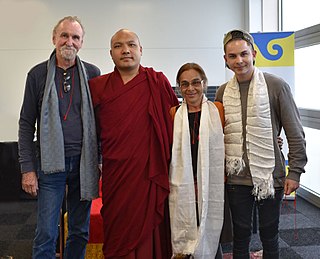
Terris Nguyen Temple, born in Bakersfield, California, May 5, 1944,died on July 8, 2024. studied the art of Tibetan thangka painting in Nepal during the years 1966 to 1975. For the past twenty five years, the Nguyen Temples have been the official artists to Ogyen Trinley Dorje, the 17th Gyalwa Karmapa, and Tsurphu Monastery, Tibet.

Lama Jigme Rinpoche is an author and teacher in the Karma Kagyu school of Tibetan Buddhism. Born into the family of Rangjung Rigpe Dorje, 16th Karmapa, he is the brother of the late 14th Shamar Rinpoche, Mipham Chokyi Lodro. The 16th Karmapa appointed Lama Jigme Rinpoche as his European representative. He asked him to oversee the development of a shedra (university), library, retreat center, and monastery at Dhagpo Kagyu Ling in Dordogne, France, where Jigme Rinpoche is currently the main representative of Trinley Thaye Dorje and head of the monastery.
